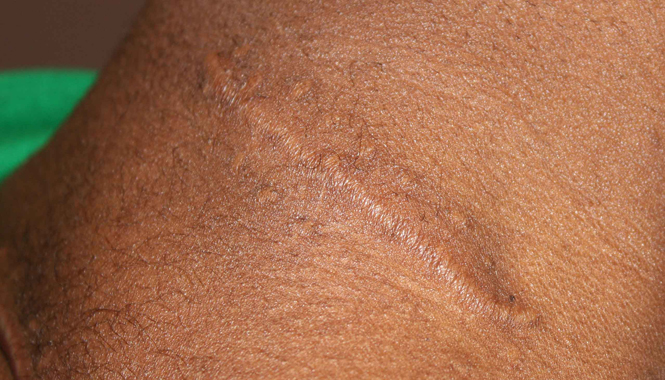

Let’s talk about scar removal surgery. Scarring can sometimes occur when the skin is healing from any type of trauma that affected several layers of skin, be it a cut, surgery, a burn, acne, pregnancy, or other traumas. Scars are permanent – always – but the appearance can be reduced through topical preparations, laser treatments, and surgical relocation. There are many different kinds of treatment, and not all treatments work on all scars. There are different types of scars including:
Burn scars, in which several layers of skin have been damaged or destroyed, which can cause the skin to heal in such a way that a red, puckered scar is left behind – sometimes the skin can become so taut that muscles and tendons can become contracted because the skin will not allow movement.
Keloid scars are a result of the skin producing too much collagen during and after the healing of a wound. Keloid scars are puffy and can grow outside the original area of the wound. Hypertrophic scars look similar to Keloids. They only grow within the original area of the wound. They are still raised, thick, and sometimes discolored.
Facial scars, whether the result of an injury or acne, can affect a person’s self-esteem, but can actually become a medical condition if they restrict facial movements.
When consulting with a doctor about scar removal, all surgical possibilities are gone over, as well as the possible side effects and complications that can result from each method.
Should You Consider Facial Scar Treatment?
Treatment for facial scars is performed to either reduce the appearance of the scar, renewable facial movements that were restricted by scar tissue, or relocate the scar. Your doctor will discuss important factors with you, including age, skin type, skin color, ethnic background, healing rates, and genetic predisposition for scarring, all factors, which can affect how well surgery will work for you.
No two scars are alike, and different kinds of scars will respond differently depending on the treatment used. Anyone considering surgical removal of scars must have realistic expectations and understand that no scar can be permanently removed. Time is also a factor, as most plastic surgeons advise that patients wait at least a year after injury before attempting to surgically correct any scar, to allow time for wounds to heal fully so that treatment will be as effective as possible.
Making the Decision to Treat Scars Surgically
Your dermatologist or plastic surgeon will examine your scars and get your medical background in order to come up with a treatment plan that will work best for your situation. The doctor will let you know what you can expect, and you will be informed about possible complications to make sure you know all the information you need to make a decision. The doctor will also talk to you about the anesthesia, the facility where the surgery will be performed, surgery support options, and cost. Your doctor will also go over the possibility that your case may need more than one procedure to see full results.
Understanding Scar Removal Surgery
This is a general description of scar revision surgery. Remember that no two surgeries are alike, and each individual case is considered separately.
If a scar is thick and restricts movement, the scar is usually entirely excised. Healthy smooth skin is lifted. Then it moves to create a “flap” over the area to make an entirely new incision line. If a skin flap is not feasible, a skin graft may instead be used. This involves taking healthy, unscarred skin from another part of the body and moving it to the new area. It will take some time for blood vessels and other soft tissues to connect to the new skin. Another method that is sometimes used is called z-plasty, which involves moving the scar into an adjacent skin fold or crease so that the appearance of the scar is minimized. Laser and dermabrasion can also be used to resurface the skin by removing the top layers, allowing new, healthy skin tissue to form. This does not remove the scar entirely, but it does reduce its appearance and discoloration. If a keloid or hyptertrophic scar is to be treated, it is sometimes injected with corticosteroids to soften the skin and make it easier to treat. These scars can be surgically excised with very fine surgical closures, making a large scar into a small, barely noticeable line.
What to Expect After Surgery
(Please note: these are general guidelines for patients to follow. Always consult with your doctor about post-operative care.) Scar removal surgery will involve a bit of discomfort. There may be swelling and bruising, as well as redness. Always follow the post-operative care instructions given to you by your surgeon. If non-dissolving sutures were used, they will be removed several days after the surgery, but remember that the wounds are not fully healed. Activity should be kept to a minimum with no stress at the surgery site, the head should be elevated when lying down, and ice packs should be used to prevent swelling. Your doctor will tell you what activities are and are not permissible. Always consult with your doctor before taking any medication, even anti-inflammatory over-the-counter medications. Scar tissues can take up to a year, sometimes more; to heal completely and before the best results can be achieved.
Follow-Up
It is important to attend all post-operative appointments and use the follow-up care guidelines. If you notice anything unusual between appointments, do not wait for the appointment – notify your doctor right away! Make sure you keep all post-op appointments.











Leave a Reply
You must be logged in to post a comment.